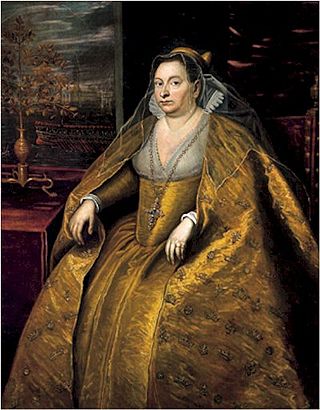Related Research Articles

Morosina Morosini-Grimani was a Venetian patrician. She was the Dogaressa of Venice from 1595 to 1606.

Dogaressa was the official title of the wife of the Doge of Venice. The title was unique for Venice: while the heads of the Republic of Genoa were also called Doge, the wives of the Doges of Genoa were not called Dogaressa, nor did they have such a public position.

Giovanna Dandolo was a dogaressa of Venice by marriage to doge Pasquale Malipiero.
Elisabetta Grimani (died August 31,
Giovanna Margherita Dalmet, also called Delmaz and Dalmaz, was a Dogaressa of Venice by marriage to the Doge Paolo Renier.
Loredana Marcello was a Dogaressa of Venice by marriage to the Doge Alvise I Mocenigo. She was an author of letters and poetry and studied botany, and was regarded as a model of an educated and cultivated renaissance woman in contemporary Venice.
Zilia Dandolo was the Dogaressa of Venice by marriage to the Doge Lorenzo Priuli.
Felicia Cornaro was the Dogaressa of Venice by marriage to the Doge Vitale I Michiel. She was politically active and exerted an acknowledged influence over the affairs of state. She was a strong supporter of the First Crusade.
Carola is the name used by Edgecumbe Staley in his book The dogaressas of Venice to refer to the Dogaressa of Venice married to Doge Obelerio degli Antenori. Among many claims, she is sometimes purported to be the first consort of a Venetian doge with the title and position of dogaressa of Venice, although this is a claim that only appears for the first time in 1858, over 1,000 years after her supposed reign. The first mention of a consort of Obelerio in the surviving historical record is in the Chronicon Altinate, said to be an unnamed daughter of Charlemagne, and several other early accounts fail to mention any wife or consort of Obelerio. Despite the lack of contemporary evidence, the consort figure in the Chronicon Altinate became part of the canon of Venetian history, and thus is found in many accounts of Obelerio's reign.
Valdrada of Sicily was a Sicilian princess and the Dogaressa of Venice by her marriage to Doge Jacopo Tiepolo.
Constance of Sicily was a Sicilian Princess and the Dogaressa of Venice by marriage to the Doge Pietro Ziani.
Alicia or Adelasa was the Dogaressa of Venice by marriage to the Doge Domenico Michele and the mother of the Doge Vital II Michele. She was politically active during the reign of her spouse, continued to be a part of the political life after his abdication in 1130, and successfully worked for Vital II Michele's election as doge.
Valdrada (Gualdrada) of Tuscany was a Dogaressa of Venice by marriage to the Doge Pietro IV Candiano.
Matelda was the Dogaressa of Venice by-marriage to the Doge Ordelafo Faliero.
Marina Galina was the Dogaressa of Venice by marriage to the Doge Michele Steno.
Alicia Giustiniani was the Dogaressa of Venice by marriage to the Doge Francesco Donato.
Marina Nani was a Dogaressa of Venice by marriage to the Doge Francesco Foscari.
Loicia (Aloicia) da Prata or Alucia da Frata was the Dogaressa of Venice by marriage to the Doge Reniero Zeno.
Aliodea Morosini, called "Dea Moro", was the Dogaressa of Venice by marriage to the Doge Nicolò Tron.
Paolina Loredan was the Dogaressa of Venice by marriage to Doge Carlo Contarini and a member of the noble Loredan family.
References
- Staley, Edgcumbe: The dogaressas of Venice : The wives of the doges , London : T. W. Laurie, 1910
- Louisa Lauw: The Dogaressa